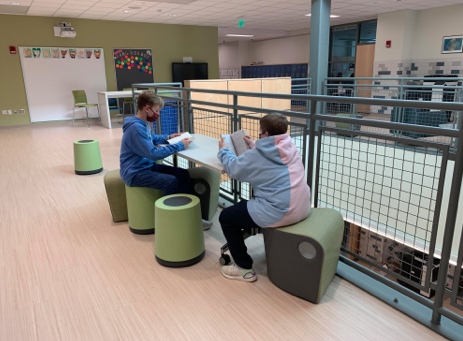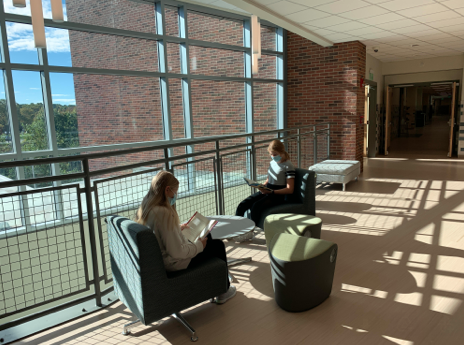Checking out books and circulation on the rise
When the state announced guidelines for re-opening buildings for the 2020-2021 school year, the district initially was not going to allow for book check out; however, in our building we have a decentralized library and the shelving is throughout the hallways. I knew the books would walk off if we didn’t have checkouts, so I met with my principal and assistant superintendent to discuss my plan. They agreed that since we already had a self-checkout process it would make the most sense to allow this for students. And yet, teachers assigned much less independent reading, we had no enrichment blocks, and students were only in the building two days a week, so circulation was markedly down.
So now we are several weeks into the 2021-2022 school year, circulation is up 93% over last year, every ELA class in the building has had an opportunity to explore the catalog and library collection and there is a great energy around reading. Of course, I knew how much I missed their activity, but after so long students are generally excited about reading and access to books. While some just missed out on the process for checking out books last year, many generally had no idea that the books they walk by everyday are there for them.
I’ve made a concerted effort to make sure there are several ways for students, staff and parents to have an understanding of the library’s print and digital operations. We also added SORA last year and I’ve recognized that I need to regularly help students and staff remember the best way to login to the Commonwealth eBook collection. This slide seems to be the most effective way I have discovered to share (and reshare) information. Staff members throughout the building place it in both their academic and advisory Google Classrooms, referring to it throughout the year. I’ve shared it with parents in our principal’s weekly newsletter and it doesn’t hurt to send it out to staff a few times per year via email. Nothing beats an active link I can regularly update, that is also easily accessible to the entire community through the mediums they use to access information.
Collaborations and Independent reading assignments
Last year independent reading understandably took a large hit in the curriculum, as students and teachers were in survival mode. This year 8th grade ELA teachers hit the ground running with book tastings from the library which got kids talking and seeking out titles. While they are the only students who have ever had a sense of “normal” in the building, that “normal” was almost 2 years ago. Most needed a full re-introduction to the library collection and its offerings. Sixth grade came next and, while there still seems to be a little hesitancy, they are finding their way, departing from the elementary model of once-a-week visits they were used to. Seventh grade ELA classes do a genre study throughout the year, so teachers spent several days introducing the library and having students complete a scavenger hunt for titles they might be interested in. The 7th graders came more prepared than ever to seek and find books to their suiting.
Book fair and PTO support
This might be the best part of our return to normal. Pre-shutdown, the PTO had organized a Scholastic Book Fair each fall. Since it didn’t happen last year and their participants have turned over as their kids have aged, there was nothing planned. Previously, I was mostly just a school contact and organizer of teacher visits. This year however, with no plan in place and a new group of parents, we are going with a book fair from our local bookstore. It’s been refreshing to help pick out the books based on our own student interest and teacher feedback. Working with the parents and the bookstore has been great so far and everyone is getting excited about having this event back in the building.
What is old is new again
Social Space
Wow: social lives and middle school drama is back with gusto. As monotonous and drab as the 2020-2021 school year was, classroom management took a backseat simply because it was easier, what with the school half full and less interaction during travel times in hallways. This year, the energy that makes up a typical middle school is at levels we haven’t seen in years. It isn’t just the academics students missed, but the practice of what it means to be a middle school student. Many of us are taking stock, slowing down, and still working with students on behavioral norms, including formal daily reminders on basic ways to interact in each of the learning spaces in the building.
Emotional Space
The last couple of years have been so mentally taxing on students and staff alike, recognizing we may not be able to keep the same pace is important. Some of the setbacks students have faced in learning might be harder if they are missing out on the social cues they normally would have been exposed to. Making room for students to express some of the overwhelming feelings, while helping them also learn to regulate those emotions is something we’ve been working on as a school. Utilizing the diversity audit function in the Titlewise Analysis in Destiny has been an excellent way to not only assess representation in our titles, but also see how many of our books support social emotional learning.
Physical Space
Middle schoolers do not always keep their hands to themselves, but, like in classrooms, with only half the population and stringent parameters for movement around the building, handsy-ness was easier to monitor. Now “keep our bodies to ourselves” is a regular refrain, and as a parent of 5 and 7 year old boys my language remains much the same in school as at home. In a building set up for project based learning, our students are having to relearn how to sit at tables together and be mindful of each others’ personal space. In addition, much of our flexible and comfortable furniture was stored last year, but is now back for students to use in our common areas. It’s so great to see students back in these spaces.
While all is not the same, there is enough familiarity in our day to day and the routine is comforting. We will continue to meet challenges with the various strategies within our building that are at the core of helping middle school students: Response to Intervention blocks, tiered interventions, bi-weekly advisories, and after school help, as well as bringing back our bi-weekly interest-based clubs block and after school activities. There’s even a dance scheduled for the fall. Perhaps this school year will be memorable for all that we have done to make students feel a part of the building again.



